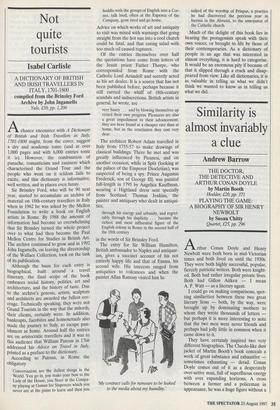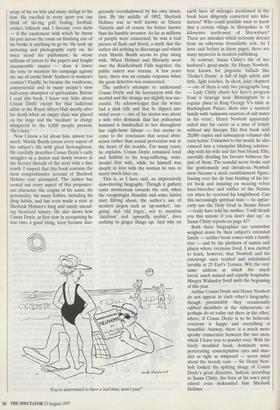Similarity is almost invariably a clue
Andrew Barrow
Arthur Conan Doyle and Henry Newbolt were both born in mid-Victorian times and both lived on until the 1930s. They were both highly successful, popular, fiercely patriotic writers. Both were knight- ed. Both had rather irregular private lives. Both had Gillon Aitken — I mean A. P. Watt — as a literary agent.
I could go on making comparisons, spot- ting similarities between these two great literary lions — both, by the way, were brought up by dominating mothers to whom they wrote thousands of letters but perhaps it is more interesting to note that the two men were never friends and perhaps had jolly little in common when it came down to it.
They have certainly inspired two very different biographies. The Cluedo-like dust jacket of Martin Booth's book conceals a work of great substance and exhaustive sometimes exhausting — detail. Conan Doyle comes out of it as a desperately over-active man, full of superfluous energy with ever expanding horizons. A cross between a farmer and a policeman in appearance, he was a huge figure without a scrap of fat on him and many strings to his bow. He excelled in every sport you can think of: ski-ing, golf, boxing, football, cricket, billiards and, I daresay, even darts — if the excitement with which he threw his pen across the room on finishing one of his books is anything to go by. He took up motoring and photography early on, he twice stood for parliament, he wrote millions of letters to the papers and fought innumerable causes — does it lower the tone to mention his campaign against the use of exotic birds' feathers in women's couture? Finally, he became the vociferous, controversial and in many people's view half-crazy champion of spiritualism. Before I read this book, I knew very little about Conan Doyle except for that ludicrous affair at the Royal Albert Hall shortly after his death when an empty chair was placed on the stage and the `medium' in charge whispered to the 8,000 people present, `He's here.'
Now I know a lot about him, almost too much. Martin Booth covers every aspect of his subject's life with great thoroughness. He carefully describes Conan Doyle's early struggles as a doctor and slowly weaves in the literary threads of the story with a fine touch. I suspect that this book contains the most comprehensive account of Sherlock Holmes ever attempted. The author has rooted out every aspect of this preposter- ous character, the origins of his name, his personality, his many foibles, including his drug habits, and has even made a start at Sherlock Holmes's long and surely unend- ing theatrical history. He also shows how Conan Doyle, at first slow in recognising he was onto a good thing, soon became dan- gerously overshadowed by his own inven- tion. By the middle of 1892, Sherlock Holmes was as well known as Queen Victoria and of course far better known than his humble inventor. As far as millions of people were concerned, he was a real person of flesh and blood, a myth that the author did nothing to discourage and which even Martin Booth seems to play along with. When Holmes and Moriarty went over the Reichenbach Falls together, the public outcry was intense. A few years later, there was an ecstatic response when the great detective was resurrected.
The author's attempts to understand Conan Doyle and his fascination with the morbid and the strange are slightly less suc- cessful. He acknowledges that the writer had a dark side and that he dipped into weird areas — one of his stories was about a wife who demands that her policeman husband is handcuffed to her throughout her eight-hour labour — but seems to come to the conclusion that sexual absti- nence rather than sexual perversion was at the heart of the trouble. For many years, he explains, Conan Doyle remained loyal and faithful to his long-suffering, semi- invalid first wife, while he himself was deeply in love with the woman he was to marry much later on.
This is, as I have said, an impressively slow-moving biography. Though it gathers some momentum towards the end, when the escapologist Houdini and some fairies start flitting about, the author's use of modern jargon such as `up-market', `on- going' and `old fogey', not to mention `database' and `upwardly mobile', does nothing to ginger things up. And why on You're determined to have a bad time, aren't you?' earth have all mileages mentioned in the book been diligently converted into kilo- metres? Who could possibly want to know that a certain village in Shropshire is 18 kilometres north-west of Shrewsbury? These are mistakes which seriously detract from an otherwise formidable text. As I have said before in these pages, there are many mysteries in modern publishing.
In contrast, Susan Chitty's life of her husband's great-uncle, Sir Henry Newbolt, best known for jingoistic ballads like `Drake's Drum', is full of high spirits and little, light touches. In short, juicy chapters — one of them is only two paragraphs long — Lady Chitty charts her hero's progress from a vicarage near Birmingham to a regular place at King George V's table at Buckingham Palace. Born into a nautical family with `unknown reserves of salt water in his veins', Henry Newbolt apparently sailed into his career as a man of letters without any hiccups. His first book sold 20,000 copies and subsequent volumes did even better. Unknown to the world, he also entered into a triangular lifelong relation- ship with his wife and her best friend, Ella, carefully dividing his favours between the pair of them. The scandal never broke and the gentlemanly and chivalrous Newbolt soon became a sleek establishment figure, fussing over the de luxe binding of his lat- est book and insisting on wearing velvet knee-breeches and ruffles of the Nelson era when he received his knighthood. Can this increasingly spiritual man — he appar- ently saw the Holy Grail in Sloane Street — really have told his mother, `I will thrash you this minute if you don't shut up,' as Susan Chitty reports on page 45?
Both these biographies are somewhat weighed down by their subject's extended family — neither book comes with a family tree — and by the plethora of names and places where everyone lived. I was excited to learn, however, that Newbolt and his entourage once resided and entertained lavishly at 23 Earl's Terrace, W8, the very same address at which the much loved, much missed and equally hospitable Margot Walmsley lived until the beginning of this year.
Arthur Conan Doyle and Henry Newbolt do not appear in each other's biography, though presumably they occasionally rubbed shoulders at the Athenaeum, or perhaps do so today out there in the ether, where, if Conan Doyle is to be believed, everyone is happy and everything is beautiful. Anyway, there is a much more spooky connection between the two men, which I leave you to ponder over. With his finely moulded head, dominant nose, penetrating, contemplative eyes and mus- cles as tight as whipcord — never mind about the tweedy suits — Sir Henry New- bolt looked the spitting image of Conan Doyle's great detective. Indeed, according to Susan Chitty, the boys at his son's prep school even nicknamed him Sherlock Holmes.



























































 Previous page
Previous page